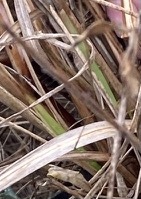Lots of tips and takeaways in this post.
This winter’s crop of Vancouver Master Gardener sprouts was awarded an extra trellis: training in the form of a two-hour session on pruning with Laurelle Oldford-Down. Out we trekked to Art’s Nursery, armed with pruners, loppers, gloves and rain gear.
Thank heavens for the rain gear: “when it rains, it pours!” – and pour it did. A smiling and somewhat damp Laurelle met us and asked whether we were OK in the rain. But gardeners are a resilient bunch, so off we sploshed like ducklings in Laurelle’s wake

There was a lot to be learned – and while here you will not get a treatise on “everything you ever wanted to know about pruning, but never dared to ask”, Lesson 1 was the major take-away: What works for one plant, does not work for another.

Ornamental grasses, for instance – Lesson 2 – require patience! If you chop them close, you might end up cutting the growing bits – so be patient until the spring when a little green starts showing at the base of a tuft – then give it a trim but not a buzz-cut! Extend this same forbearance to plants like Euphorbia or winter-blooming heathers after they have bloomed: wait till the green ‘babies’ start at the base before tackling the top of the plant, and then just cut off the spent flowers – and then shape. This also works for lavender and rosemary.
Lesson 3 – yes, you can prune hellebores! Those winter-ravaged leaves that “look like they’ve been in a bar brawl” are good to go. Once the flowers are in bloom, the next set of leaves is on its way. So chop happy! Herbaceous plants and shrubs are generally good for “Zen and the art of procrastination” pruning. Snip, drop, mulch, contemplate. Yes, Lesson 1.

Once through the herbaceous perennials, the group paddled its way to the conifers where came Lesson 4: you can direct the shape of a conifer by removing candles that don’t go in your desired direction; same for snipping off cedar wing-tips. Based on the shape of the tree, visualize where it will be going/growing and remove growing tips that are aimed in the wrong direction. Where these are thicker stems, make clean, dry, angled cuts close to the originating branch. But not too close. Some plants – not only conifers – will die back from the cut – so leave a little – wait till it turns brown – and then cut that last bit off.
Lesson 5 – unless you’re into apple orchards and know what you’re doing and growing, ask an expert. The varietal will get you every time. Some apples produce fruit on terminal spurs; some not – and some on both. Apparently, there are even some multi-grafted Franken-apple trees that need different pruning styles for each graft on the rootstock. Back to Lesson 1. What does help is taking a close look to figure out which are the flower buds and which buds produce leaves. Mother nature does give some hints – so prune accordingly. Pruning fruit trees is for fruit production – so all rules for pruning other trees go out the window. Shape is not as important as the angle of the branch, the height of the tree – who wants to pick from the top of a rickety ladder? – and open access to the branches.

Berries, too, need pruning, but they are a different world. Where blueberries need to have a mix of younger and older, upright canes for plentiful fruit, and can be pruned, huckleberries, on the other hand, not really. You have to be kind to them and treat them gently. So Lesson 1.
Ornamental trees are another something else again. There is the tree tree, that you plant and leave alone to be a tree – and do its tree thing. These, one prunes for the classical 3 Ds – “dead, diseased, damaged” and shape and use. Then there are the ones suitable for doing weird, unnatural haircuts with – such as pussy willows. They can be pruned into all sorts of curious waterfall shapes. However, the designer cuts can go awfully wrong, to the point of literally unbalancing a tree till it topples. Then comes the rescue-pruning where you need to enlist nature to realign nurture. For them, and for many trees, dormancy pruning is best. But how do you know whether a tree is dormant?

Lesson 6: do a test cut. Cut a small branch to see if the cut bleeds. If it does bleed – leave the poor tree alone till next winter. Unless, of course, you are using summer pruning to control the size or other aspect of the tree. Then all bets are off as summer pruning is no longer ‘forbidden’. Again, back to Lesson 1.
When we asked how to handle Wisteria, the answer came, “They are great for ‘rage pruning’!” Prune anything and anytime, but prune! Train them to the shape and direction you want.
Lesson 7 – Think it through. Decide what the pruning goal is and how to achieve it. Step back and think. The carpenters’ maxim, “measure twice, cut once” holds here too. Think twice before damaging the plant – but once you’re sure, do what is best for it.

By the time we had absorbed all this, Laurelle was thoroughly drenched but still happy and smiling as she bade farewell to her soggy followers. Surprise, surprise! During the walk around the nursery we had accumulated not only knowledge, but a long list for the next round of plant shopping.
![]() &
&![]() Student VMG
Student VMG![]() Maria I.
Maria I.